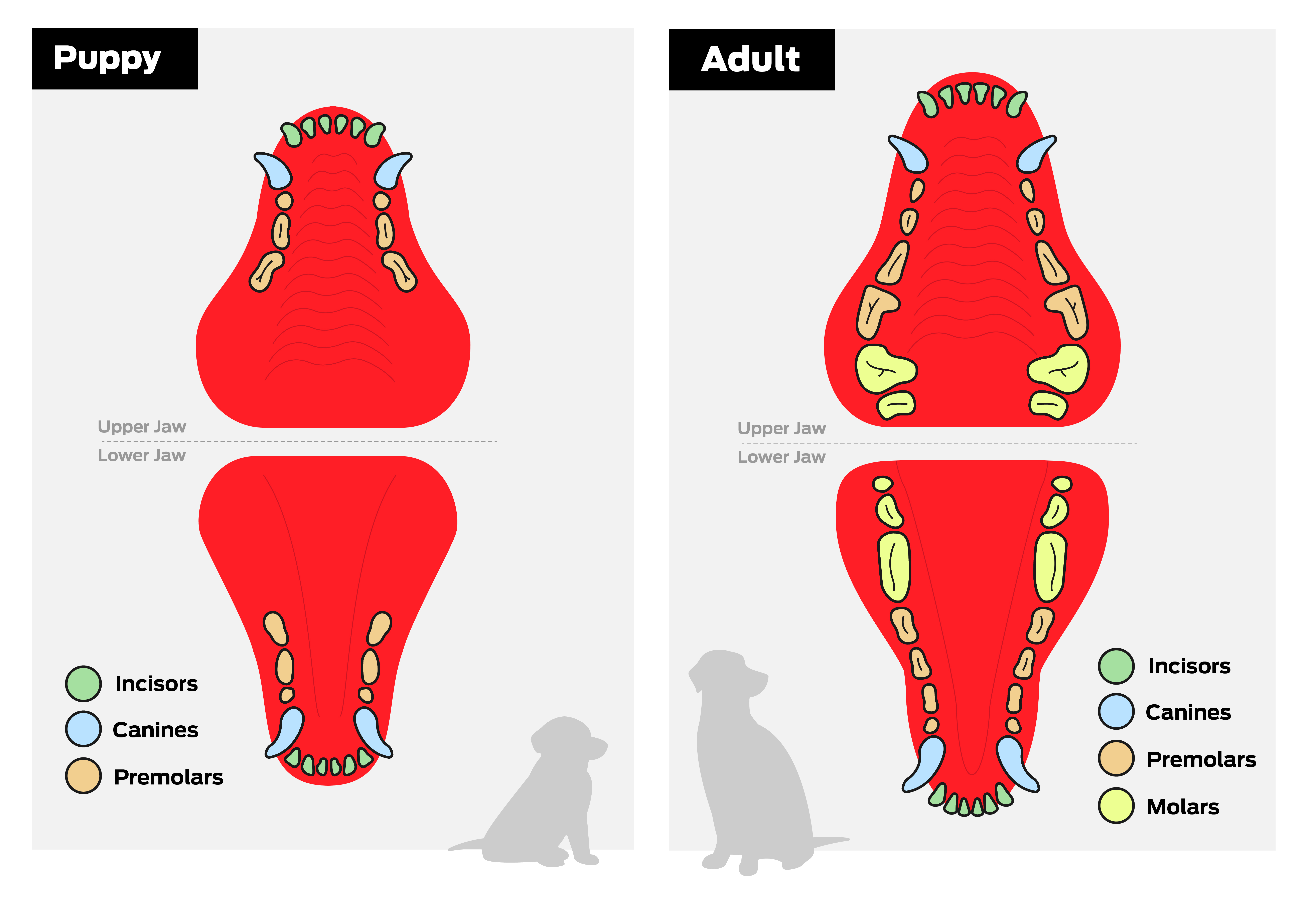
The first few months of raising a puppy are full of play, snuggles, exploring – and growing! Watching your puppy learn and develop is equal parts rewarding and exciting.
One important part of their growth is teething. Like humans, puppy teething is a necessary phase. You may have a number of questions about your teething puppy such as:
- When do puppies lose their baby teeth?
- What do puppy teeth look like when they fall out?
- How long does puppy teething last?
- How do I stop teething puppies from biting?
In this article, we’ll dive into the many facets of puppy teeth development so you can feel confident no matter which puppy teething stage you’re experiencing.
Why Do Puppies Teethe?
Teething is a critical part of a puppy’s growth and development. When puppies are first born, they don’t need teeth, but eventually they do. Their adult teeth are needed for chewing their food, and how their adult teeth grow is important for their overall health.
When Do Puppies Start Teething?
Puppies start teething at around 12-16 weeks of age. This puppy teething age marks the loss of their deciduous teeth (also known as baby teeth or milk teeth) and the growth of their adult teeth. If you’re wondering, How many teeth do puppies have?, in total, your puppy will develop 42 adult teeth after they lose their 28 baby teeth.
Puppy Teething Stages
To understand puppy teething, the puppy teeth chart below will help give you a timeline with significant milestones by age. Keep this puppy teething timeline handy so you can stay on top of each stage to come.
| Stage | Age | What to Expect |
|---|---|---|
| Stage 1: No Teeth | Birth to 2 weeks | At this early stage of birth to 2 weeks of age, your puppy has no teeth. They’re not needed this early as puppies get their nutrition through their mother’s milk. |
| Stage 2: Deciduous Incisors (aka Puppy Teeth) | 3-4 weeks | Incisors start to grow. There are 12 total – six on top and six on bottom. They help with grasping food, grooming and nibbling. |
| Stage 2: Deciduous Incisors (aka Puppy Teeth) | 3-4 weeks | Four canine teeth emerge next. These teeth help with biting and tearing. Deciduous premolars come in around 6 weeks of age. All baby teeth should be present at their 6-8 week veterinary appointment. |
| Stage 4: Adult Premolars | 3-5 months | Adult premolars start to emerge. |
| Stage 5: Adult Molars | 4-5 months | Adult molars start to emerge. |
| Stage 6: All Teeth | 5-7 months | All 42 adult teeth are in place. |
Puppy Dental Anatomy
If you’re curious about where the different types of teeth are placed in your puppy’s mouth, take a look at the diagram below. This illustration of their dental anatomy shows where their incisors, canines, premolars and molars are located.

When Do Puppies Stop Teething?
The process of teething typically takes about four months. Around 5-7 months of age, your puppy’s adult molars should be in place. While this technically signals the end of teething, puppies are natural chewers. So, the chewing behaviors you may have seen as a form of relief during teething will likely continue – albeit in less extreme ways.
Puppy Teething Symptoms
There are many symptoms associated with puppy teething. To name a few, there’s puppy teething loss of appetite, puppy biting or nipping and mild pain. Read on to learn more about telltale signs of teething.
Chewing
The most obvious sign of puppy teething behavior is their desire to chew everything. They resort to chewing to help ease their irritated gums as the process of losing their puppy teeth and forming new ones isn’t very comfortable. In fact, some puppies may experience a bit of pain during this process.
Bad Breath
You may also notice your puppy has bad breath while teething. Sometimes teething can cause inflammation of their gums and gingivitis, which in turn, can result in puppy bad breath. Teething doesn’t last forever, though, so the inflammation, gingivitis and resulting bad breath will likely go away on their own once teething ends.
Losing Teeth
Another common sign of teething is your puppy losing teeth. You may randomly notice them on the floor. They’re tiny – about the size of a grain of rice. But there’s no reason to worry when you see them. If your puppy’s teeth are falling out at this young age, it’s a positive sign of their growth and development.
There are other puppy teething symptoms and side effects to watch for including:
- Decreased appetite
- Increased drooling
- Minimal bleeding
- Mild pain
- Low fever
If you notice these puppy teething side effects, they’re not a major cause for concern. You can learn about puppy teething remedies, though, in the next section of this article.
How to Help a Teething Puppy
It isn’t easy to witness puppy teething pain, or the side effects associated with it, like puppy teething loss of appetite or puppy drooling. Teething remedies can help, though. Read on for a few home remedies for teething puppies as well as basic preventative measures you can take to safeguard your pup.
1. Puppy-Proof Your Home
When a teething puppy has free reign of your home, they’ll be on a mission for the most chew-worthy objects. Puppies are natural chewers, and the puppy teething pain they’re experiencing can exacerbate their desire to chew.
It’s important to keep them safe from anything they could destroy or consume. Stow away any electrical cords, shoes, clothing, medications and trash cans. Beyond these teething puppy tips, you can also get a complete list of items you should safely secure by reading our article about puppy-proofing your home.
2. Provide a Variety of Chew Toys
If you want to learn how to stop puppy biting and deter your puppy from chewing everything in sight, be sure to provide ample toys that they’re allowed to chew. There are a number of durable toys you can consider, including ones made specifically for teething such as puppy teething rings. You might also purchase dental chew treats as another form of satisfying their need to chew.
When it comes to toys, though, rope toys or any toys that involve tugging or pulling aren’t the best teething toys for puppies. In fact, it’s best to avoid them. Playing tug-of-war with a teething puppy could cause further pain to their tender or sore gums. It’s best to rule out tugging to protect this sensitivity.
3. Try Home Remedies for Teething Puppies
One home remedy to try is experimenting with cool temperatures to soothe your puppy’s gums. This method of puppy teething pain relief is simple and easy to do at home. Put a chew toy in the freezer or give them frozen baby carrots as a treat. Avoid serving ice cubes to teething puppies, though. They’re too rough on their teeth and can be easily swallowed whole.
Puppy Teething Advice
When your puppy is in the thick of teething, you may wonder if the chewing, biting, nipping and other symptoms will ever end. Like most things when it comes to raising a puppy, it’s a phase. Eventually, all their adult teeth will grow in, and you’ll look back and wonder how you survived it all.
It’s important to bear in mind, though, that while the chewing and biting subside, depending on the type of breed, you may want to get used to having a natural born chewer in your home. Continuing the same puppy teething remedies while providing safe toys and spaces for your puppy is good for their well-being and enrichment.
If you feel the need for more expert advice on how to help a teething puppy, it’s always good to consult your veterinarian for help. Puppy teething is a phase every puppy goes through, but it never hurts to get tailored veterinary advice based on your puppy’s specific needs.
For more expert tips on your puppy's health, explore our other puppy health articles.

Be Rewarded for Your Purina Purchases
Earn and redeem points for Purina products with myPurina app.




